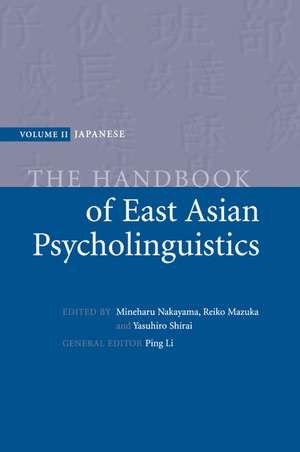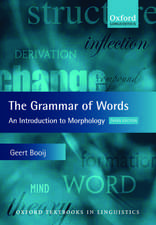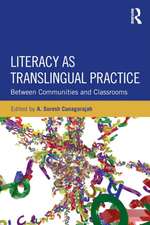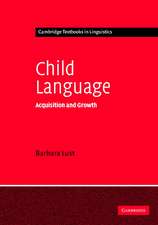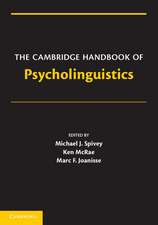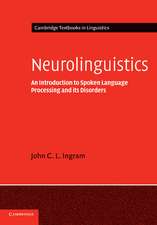The Handbook of East Asian Psycholinguistics: The Handbook of East Asian Psycholinguistics 3 Volume Paperback Set
Editat de Mineharu Nakayama, Reiko Mazuka, Yasuhiro Shirai Ping Lien Limba Engleză Paperback – iul 2015
Preț: 337.68 lei
Nou
Puncte Express: 507
Preț estimativ în valută:
64.62€ • 70.17$ • 54.28£
64.62€ • 70.17$ • 54.28£
Carte tipărită la comandă
Livrare economică 22 aprilie-06 mai
Preluare comenzi: 021 569.72.76
Specificații
ISBN-13: 9781107504578
ISBN-10: 1107504570
Pagini: 428
Ilustrații: 11 tables
Dimensiuni: 153 x 230 x 23 mm
Greutate: 0.57 kg
Editura: Cambridge University Press
Colecția Cambridge University Press
Seria The Handbook of East Asian Psycholinguistics 3 Volume Paperback Set
Locul publicării:New York, United States
ISBN-10: 1107504570
Pagini: 428
Ilustrații: 11 tables
Dimensiuni: 153 x 230 x 23 mm
Greutate: 0.57 kg
Editura: Cambridge University Press
Colecția Cambridge University Press
Seria The Handbook of East Asian Psycholinguistics 3 Volume Paperback Set
Locul publicării:New York, United States
Cuprins
Part I. Language Acquisition: 1. Ontogeny of language Nubou Masataka; 2. Caregiver's speech Toshiki Murase and Tamiko Ogura; 3. The intrinsic linkage between gesture and speech in the prelinguistic stage Keiko Ejiri and Nobuko Uchida; 4. Infant speech perception Akiko Hayashi; 5. Phonological acquisition Mitsuhiko Ohta; 6. Mechanism of lexical development: implications from Japanese children's word learning Mutsumi Imai; 7. The acquisition of nouns and verbs in Japanese Yuriko Oshima-Takane; 8. The acquisition of verbal nouns Yutaka Sato and Yoshi Yamashita; 9. The acquisition of Japanese numeral classifiers Kasumi Yamamoto; 10. The acquisition of case markers Hiromi Morikawa; 11. The acquisition of tense and aspect Yasuhiro Shirai; 12. On the origin of children's errors: the case of Japanese negation and direct passive Tetsuya Sano; 13. Binding theory in UG and first language acquisition of Japanese Barbara Lust; 14. The acquisition of the particles, 'ne', 'yo' and 'no' Haruko Minegishi Cook; 15. The acquisition of linguistic politeness in Japanese Keiko Nakamura; 16. Children's narrative structures Masahiko Minami; 17. Memory talk and testimony in children Makiko Naka; 18. Developmental dyslexia Jun Yamada; 19. Japanese sign language Takashi Torigoe; 20. The role of an innate acquisition device in second language acquisition Kazue Kanno; 21. Japanese, the grammar of reflexives, and second language acquisition Margaret Thomas; 22. Processes in L2 Japanese sentence production Noriko Iwasaki; 23. Development of lexical competence among second-language readers Keiko Koda; 24. Reading in Japanese as a second language Yukie Horiba; 25. International code-switching in Japanese and English Miwa Nishimura; Part II. Language Processing: 26. Phonetic and phonological organizations of speech in Japanese Haruo Kubozono; 27. Speech segmentation by Japanese listeners: its language-specificity and language-universality Takashi Otake; 28. Prosody in sentence processing Jennifer Venditti; 29. Speech errors Yasushi Terao; 30. Effects of word properties on Japanese sentence processing Tadahisa Kondo and Reiko Mazuka; 31. Orthographic processing Hirofumi Saito; 32. Lexical access Taeko Wydell; 33. Incrementality in Japanese sentence processing Yuki Kamide; 34. Processing alternative word orders Edson Miyamoto; 35. Processing of relative clauses in Japanese: coping with multiple ambiguities Yuki Hirose; 36. Processing of empty categories in Japanese Tsutomu Sakamoto; 37. Difficulty of certain sentence constructions in comprehension Mineharu Nakayama, Shravan Vashisth and Richard L. Lewis; 38. Reading and working memory Mariko Osaka; 39. Sentence production in Japanese Hiroko Yamashita and Franklin Chang; 40. Neural basis of syntactic processing in Japanese Hiroko Hagiwara; 41. The competition model Yoshinori Sasaki and Brian McWhinney; 42. Connectionist models Michiro Negishi; 43. Computational linguistics Masayuki Asahara, Yasuharu Den and Yuji Matsumoto; 44. Language and gesture as a single communicative system Nobuhiro Furuyama.
Recenzii
'It is particularly of great use to those who wish to get acquainted with the range of psycholinguistic research concerned with these languages and/or to examine how (language-)specific phenomena are discussed from the psycholinguistic point of view.' Language
Descriere
This handbook presents a state-of-the-art discussion of the psycholinguistic study of Japanese.
